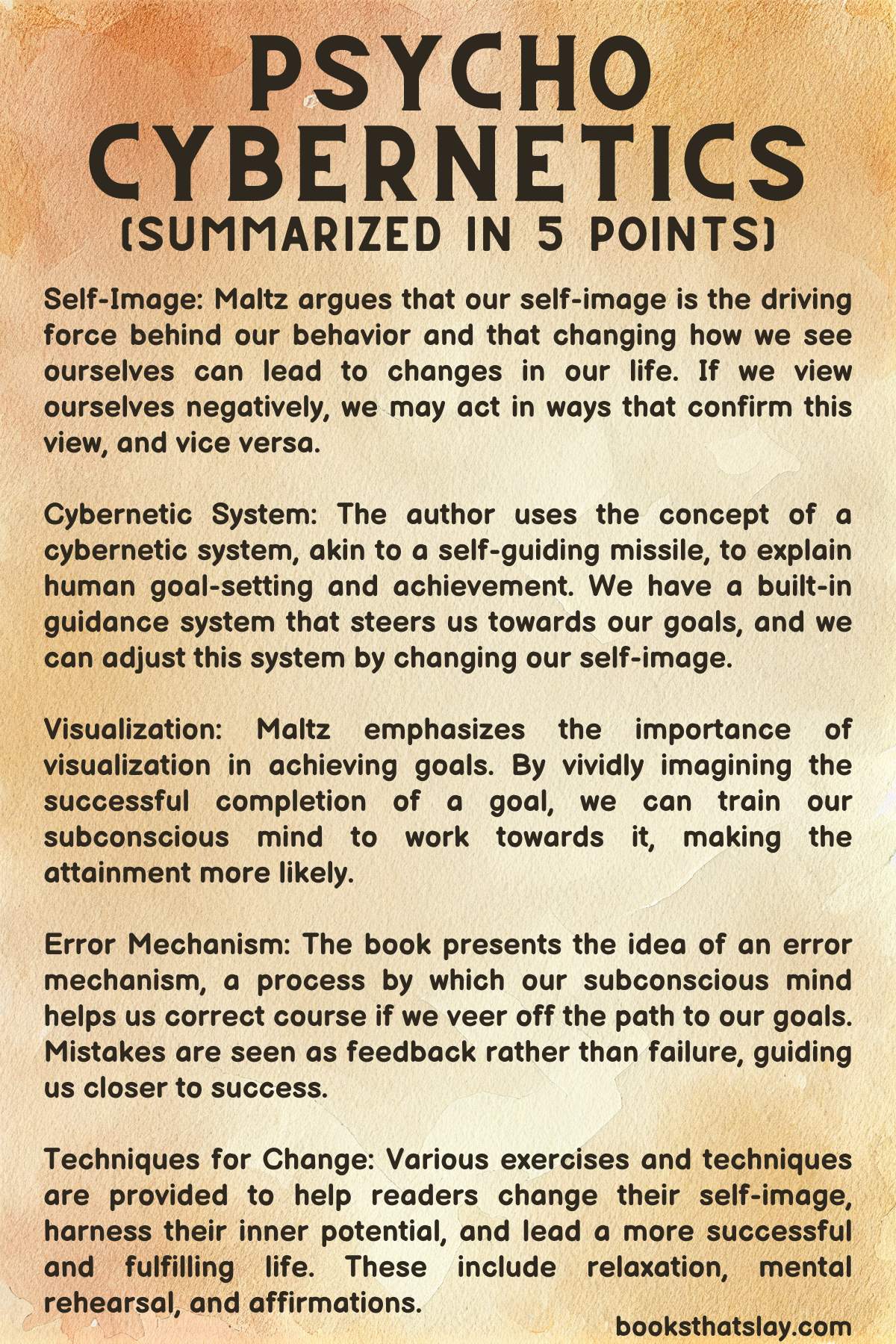Psycho-Cybernetics | Summary and Key Lessons
“Psycho-Cybernetics” is a seminal self-help book first published in 1960 by Maxwell Maltz, a plastic surgeon who observed the impact of self-image on the well-being and success of his patients. Maltz presents a framework for improving one’s self-image and, by extension, improving one’s life.
The title of the book refers to the concept of a ‘steersman’ — the ‘cybernetic’ component that guides and directs the psychological processes.
Psycho-Cybernetics Summary
The Importance of Self-Image
Maltz emphasizes the concept of ‘self-image‘ as the cornerstone of a person’s habits and behaviors. He posits that our self-image is a mental blueprint of ourselves — not necessarily reflective of reality, but rather of our beliefs about ourselves.
This self-image guides our actions and behaviors, and if it’s negative or distorted, it can limit our capabilities.
Cybernetic Mechanism
Maltz draws on the principles of cybernetics, the study of how systems self-regulate and steer toward their goals. He applies these principles to human psychology and describes the mind as a ‘goal-seeking mechanism’.
The brain, he explains, operates on a ‘set point‘ defined by our self-image, much like a thermostat regulates temperature. Changing the ‘set point’ by altering our self-image can lead to behavioral change.
The Success Mechanism
The ‘success mechanism’ is a concept Maltz introduces to illustrate how the mind can be guided towards successful behavior.
This mechanism involves clear goal-setting and visualization techniques. By clearly defining what success looks like and constantly visualizing this, individuals can steer their minds and behavior towards achieving these goals.
Role of the Conscious and Subconscious Mind
Maltz discusses the roles of the conscious and subconscious mind in shaping our behavior.
The conscious mind sets goals and makes judgments, while the subconscious mind works on the goals set by the conscious mind, without questioning their feasibility.
If the conscious mind sets negative goals, the subconscious will work towards those, leading to self-fulfilling prophecies.
Techniques for Changing Self-Image
Maltz provides various techniques for improving one’s self-image.
These include visualization, mental rehearsal, relaxation, and affirmations. By repeatedly visualizing a positive self-image and successful scenarios, one can effectively reprogram the subconscious mind to aim for these outcomes.
He also emphasizes the importance of forgiving past mistakes, arguing that carrying forward past negatives can hinder self-improvement efforts.
Role of Emotions
According to Maltz, emotions are the product of our beliefs, not external circumstances. He encourages readers to not be overly influenced by negative emotions, as they often stem from false beliefs. He suggests that by changing our beliefs, we can control our emotional responses.
Criticism and Failure
Maltz discusses the role of criticism and failure in personal growth. He suggests viewing failures as learning opportunities rather than signs of personal shortcomings.
Also, he advises not taking criticism personally but using it constructively to improve and refine behaviors.
Happiness
Maltz concludes the book by discussing happiness.
He suggests that happiness is a byproduct of purposeful activity, not a goal in itself. By focusing on meaningful and purposeful activities, and by cultivating a positive self-image, happiness will naturally follow.

Also Read: Outwitting the Devil | Summary and Key Lessons
What can you learn from the book?
1. Self-Image and Its Power
According to Maltz, each of us has an internalized mental image of ourselves, which significantly impacts our behavior, performance, and self-esteem. He argues that this self-image can be either positive or negative, and that a poor self-image can prevent us from achieving our full potential.
It is a self-fulfilling prophecy, where if we view ourselves as incompetent or unworthy, we are likely to behave in ways that confirm this view.
Conversely, if we see ourselves as capable and valuable, we are likely to perform at a higher level and pursue our goals more vigorously.
Maltz advocates for regular visualization techniques to alter our self-image positively and consequently improve our performance and personal satisfaction.
2. Power of Imagination and Visualization
Maltz, as a plastic surgeon, noticed that changing people’s physical appearance often didn’t lead to an increase in their happiness or self-esteem.
The reason was their unchanged self-image or the mental picture they held of themselves. He thus suggested the ‘theatre of the mind‘ technique, where we consistently visualize our desired outcomes.
For instance, if someone aspires to be a public speaker but is afraid, they can regularly visualize themselves speaking confidently in front of a large audience. Over time, this mental rehearsal can help alleviate anxiety and improve performance.
Also Read: The Warmth of Other Suns | Summary
3. Emotional Resilience and the Art of ‘Forgetting’
Maltz introduced the idea of ‘conscious forgetting’ as a way to enhance emotional resilience.
According to him, past failures and negative experiences can form mental scars that hinder our present and future actions. By consciously deciding to ‘forget’ past failures or negative experiences, we can free ourselves from the crippling impact of these memories.
For example, if a person had a terrible experience with public speaking, the memory of this event might prevent them from trying again. However, by consciously choosing to ‘forget’ this experience, they can reduce their anxiety and approach public speaking with renewed confidence.
4. Goal Setting and the Automatic Success Mechanism
The book emphasizes the importance of clear goal setting, which Maltz describes as engaging our ‘Automatic Success Mechanism‘ (ASM). He argues that just like a guided missile, our brain can be programmed to move towards a specified target.
By having a clear and precise image of our desired outcome, we can guide our actions and behaviors towards achieving this goal.
Maltz suggests using visualization and positive affirmations to impress our goals upon our subconscious mind, which will then guide our actions towards achieving these goals.
Final Thoughts
“Psycho-Cybernetics” is considered groundbreaking because it combines cognitive psychology and the science of cybernetics to create a framework for personal development. The book emphasizes the power of the mind in shaping behavior and achieving success, providing practical tools for improving self-image and harnessing this power effectively.
Also Read: